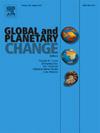Low oxygen levels and fluctuated redox states of continental shelf seawater after the Cambrian explosion
IF 4
1区 地球科学
Q1 GEOGRAPHY, PHYSICAL
引用次数: 0
Abstract
The Cambrian Miaolingian and Furongian (509–485 Ma) represent a critical transitional interval in evolutionary history of animals, bridging the Cambrian explosion to Great Ordovician Biodiversification Event (GOBE). Despite its significance, scant attention has been directed toward understanding the shifts in marine redox conditions and biogeochemical cycles during this epoch, hampering the broader understanding of linkages between marine environment and early animal radiation. Here we present new paired sulfur isotope records from carbonate-associated sulfate (δ34SCAS) and pyrite (δ34Spy), along with nitrogen isotopes (δ15Ndecarb) from a continuous carbonate succession in South China, aiming to better constrain marine redox states and biogeochemical cycles during the middle-late Cambrian (ca. 509–495 Ma). Overall low sulfur isotope offsets Δ34SCAS-py (Δ34SCAS-py = δ34SCAS-δ34Spy, 1.1–46.6‰,median = 21.0‰) indicate continuously low seawater sulfate concentrations during middle-late Cambrian. The consistently low δ15Ndecarb values (−1.4–2.3‰,median = 0.4‰) suggest that this period was featured by active nitrogen fixation and a small nitrate reservoir in the shallow ocean. Taken together, the sulfur and nitrogen isotopic data can be best explained by persistently low global oxygenation levels of the middle-late Cambrian oceans. Meanwhile, high variabilities of Δ34SCAS-py and δ15Ndecarb recorded by the studied section also suggest fluctuated marine redox conditions on continental margins during this period. In combination with paleontological records, we propose that persistently low marine oxygenation levels and frequent expansion of anoxic seawater on continental margins may have induced a trough period in animal biodiversification after the Cambrian explosion.
寒武纪大爆发后大陆架海水的低氧水平和波动氧化还原状态
寒武纪庙岭期和芙蓉期(509-485 Ma)是动物进化史上的一个关键过渡时期,连接了寒武纪大爆发和奥陶纪生物多样化大事件(GOBE)。尽管其意义重大,但人们对这一时期海洋氧化还原条件和生物地球化学循环的变化了解甚少,这妨碍了对海洋环境与早期动物辐射之间联系的广泛了解。在此,我们展示了来自华南地区连续碳酸盐层序的碳酸盐相关硫酸盐(δ34SCAS)和黄铁矿(δ34Spy)的新的成对硫同位素记录,以及氮同位素(δ15Ndecarb)记录,旨在更好地解释中晚寒武纪(约 509-495 Ma)的海洋氧化还原状态和生物地球化学循环。总体较低的硫同位素偏移量Δ34SCAS-PY(Δ34SCAS-PY = δ34SCAS-δ34Spy, 1.1-46.6‰,中值 = 21.0‰)表明中晚寒武纪海水硫酸盐浓度持续较低。δ15Ndecarb值持续偏低(-1.4-2.3‰,中值=0.4‰),表明这一时期固氮作用活跃,浅海硝酸盐储量较小。综合来看,中晚寒武世海洋持续的全球低含氧量最能解释硫、氮同位素数据。同时,所研究断面记录到的Δ34SCAS-py和δ15Ndecarb的高变率也表明了这一时期大陆边缘海洋氧化还原条件的波动。结合古生物学记录,我们提出,持续的低海洋含氧量和大陆边缘缺氧海水的频繁扩张可能诱发了寒武纪大爆发后动物生物多样性的低谷期。
本文章由计算机程序翻译,如有差异,请以英文原文为准。
求助全文
约1分钟内获得全文
求助全文
来源期刊

Global and Planetary Change
地学天文-地球科学综合
CiteScore
7.40
自引率
10.30%
发文量
226
审稿时长
63 days
期刊介绍:
The objective of the journal Global and Planetary Change is to provide a multi-disciplinary overview of the processes taking place in the Earth System and involved in planetary change over time. The journal focuses on records of the past and current state of the earth system, and future scenarios , and their link to global environmental change. Regional or process-oriented studies are welcome if they discuss global implications. Topics include, but are not limited to, changes in the dynamics and composition of the atmosphere, oceans and cryosphere, as well as climate change, sea level variation, observations/modelling of Earth processes from deep to (near-)surface and their coupling, global ecology, biogeography and the resilience/thresholds in ecosystems.
Key criteria for the consideration of manuscripts are (a) the relevance for the global scientific community and/or (b) the wider implications for global scale problems, preferably combined with (c) having a significance beyond a single discipline. A clear focus on key processes associated with planetary scale change is strongly encouraged.
Manuscripts can be submitted as either research contributions or as a review article. Every effort should be made towards the presentation of research outcomes in an understandable way for a broad readership.
 求助内容:
求助内容: 应助结果提醒方式:
应助结果提醒方式:


